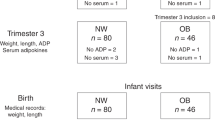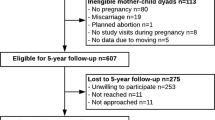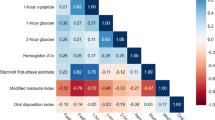Abstract
Objective
Increased infant birth weight and adiposity are associated with an altered risk of adult chronic diseases. The objective was to investigate the association between maternal dietary fat intake during pregnancy and newborn adiposity.
Study design
The study included 79 singleton pregnancies. Associations between maternal dietary fat intake during each trimester and infant adiposity at birth were assessed.
Result
Average total grams of maternal total dietary fat and unsaturated fat intake during pregnancy correlated with infant percent body fat after adjusting for potential confounding variables (r = 0.23, p = 0.045; r = 0.24, p = 0.037). Maternal average daily intake of total fat, saturated fat, and unsaturated fat during the second trimester of pregnancy were each associated with infant percent body fat (r = 0.25, p = 0.029; r = 0.23, p = 0.046; r = 0.25, p = 0.031; respectively).
Conclusions
The second trimester of pregnancy is a key time period for fetal adipose tissue metabolic programming and therefore a target for nutritional intervention.
This is a preview of subscription content, access via your institution
Access options
Subscribe to this journal
Receive 12 print issues and online access
$259.00 per year
only $21.58 per issue
Buy this article
- Purchase on Springer Link
- Instant access to full article PDF
Prices may be subject to local taxes which are calculated during checkout
Similar content being viewed by others
References
Barker DJ. The origins of the developmental origins theory. J Intern Med. 2007;261:412–7.
Demerath EW, Reed D, Choh AC, Soloway L, Lee M, Czerwinski SA, et al. Rapid postnatal weight gain and visceral adiposity in adulthood: the Fels Longitudinal Study. Obesity. 2009;17:2060–6.
Fukuoka H. DOHaD (Developmental Origins of Health and Disease) and Birth Cohort Research. J Nutr Sci Vitaminol. 2015;61(Suppl):S2–4.
Heindel JJ, Vandenberg LN. Developmental origins of health and disease: a paradigm for understanding disease cause and prevention. Curr Opin Pediatr. 2015;27:248–53.
Law CM, Barker DJ, Osmond C, Fall CH, Simmonds SJ. Early growth and abdominal fatness in adult life. J Epidemiol Community Health. 1992;46:184–6.
Yajnik CS, Fall CHD, Coyaji KJ, Hirve SS, Rao S, Barker DJP, et al. Neonatal anthropometry: the thin–fat Indian baby. The Pune Maternal Nutrition Study. Int J Obes. 2003;27:173.
Kabaran S, Besler HT. Do fatty acids affect fetal programming? J Health Popul Nutr. 2015;33:14.
Pereira-da-Silva L, Cabo C, Moreira AC, Papoila AL, Virella D, Neves R, et al. The effect of long-chain polyunsaturated fatty acids intake during pregnancy on adiposity of healthy full-term offspring at birth. J Perinatol. 2015;35:177–80.
Armitage JA, Khan IY, Taylor PD, Nathanielsz PW, Poston L. Developmental programming of the metabolic syndrome by maternal nutritional imbalance: how strong is the evidence from experimental models in mammals? J Physiol. 2004;561(Pt 2):355–77.
Krasnow SM, Nguyen ML, Marks DL. Increased maternal fat consumption during pregnancy alters body composition in neonatal mice. Am J Physiol Endocrinol Metab. 2011;301:E1243–53.
Moore BF, Harrall KK, Sauder KA, Glueck DH, Dabelea D. Neonatal adiposity and childhood obesity. Pediatrics. 2020;146:e20200737.
Crume TL, Brinton JT, Shapiro A, Kaar J, Glueck DH, Siega-Riz AM, et al. Maternal dietary intake during pregnancy and offspring body composition: the healthy start study. Am J Obstet Gynecol. 2016;215:609.e1–e8.
Blumfield ML, Hure AJ, MacDonald-Wicks LK, Smith R, Simpson SJ, Giles WB, et al. Dietary balance during pregnancy is associated with fetal adiposity and fat distribution. Am J Clin Nutr. 2012;96:1032–41.
Chen LW, Tint MT, Fortier MV, Aris IM, Bernard JY, Colega M, et al. Maternal Macronutrient Intake during Pregnancy Is Associated with Neonatal Abdominal Adiposity: The Growing Up in Singapore Towards healthy Outcomes (GUSTO) Study. J Nutr. 2016;146:1571–9.
Horan MK, McGowan CA, Gibney ER, Donnelly JM, McAuliffe FM. Maternal low glycaemic index diet, fat intake and postprandial glucose influences neonatal adiposity-secondary analysis from the ROLO study. Nutr J. 2014;13:78.
Marshall NE, Lau B, Purnell JQ, Thornburg KL. Impact of maternal obesity and breastfeeding intention on lactation intensity and duration. Matern Child Nutr. 2019;15:e12732.
Catalano PM, Thomas AJ, Avallone DA, Amini SB. Anthropometric estimation of neonatal body composition. Am J Obstet Gynecol. 1995;173:1176–81.
International Association of Diabetes and Pregnancy Study Groups Recommendations on the Diagnosis and Classification of Hyperglycemia in Pregnancy. Diabetes Care. 2010;33:676–82.
Wallace JM, Milne JS, Aitken BW, Aitken RP, Adam CL. Ovine prenatal growth-restriction and sex influence fetal adipose tissue phenotype and impact postnatal lipid metabolism and adiposity in vivo from birth until adulthood. PLoS ONE. 2020;15:e0228732.
Szabo AJ. Transferred maternal fatty acids stimulate fetal adipogenesis and lead to neonatal and adult obesity. Med Hypotheses. 2019;122:82–8.
Mennitti LV, Oliveira JL, Morais CA, Estadella D, Oyama LM, Oller do Nascimento CM, et al. Type of fatty acids in maternal diets during pregnancy and/or lactation and metabolic consequences of the offspring. J Nutr Biochem. 2015;26:99–111.
Innis SM. Fatty acids and early human development. Early Hum Dev. 2007;83:761–6.
Aiken CE, Ozanne SE. Sex differences in developmental programming models. Reproduction 2013;145:R1–13.
Ribaroff GA, Wastnedge E, Drake AJ, Sharpe RM, Chambers TJG. Animal models of maternal high fat diet exposure and effects on metabolism in offspring: a meta-regression analysis. Obes Rev. 2017;18:673–86.
Mao J, Zhang X, Sieli PT, Falduto MT, Torres KE, Rosenfeld CS. Contrasting effects of different maternal diets on sexually dimorphic gene expression in the murine placenta. Proc Natl Acad Sci USA. 2010;107:5557–62.
Block G, Woods M, Potosky A, Clifford C. Validation of a self-administered diet history questionnaire using multiple diet records. J Clin Epidemiol. 1990;43:1327–35.
Boucher B, Cotterchio M, Kreiger N, Nadalin V, Block T, Block G. Validity and reliability of the Block98 food-frequency questionnaire in a sample of Canadian women. Public Health Nutr. 2006;9:84–93.
Starling AP, Sauder KA, Kaar JL, Shapiro AL, Siega-Riz AM, Dabelea D. Maternal dietary patterns during pregnancy are associated with newborn body composition. J Nutr. 2017;147:1334–9.
Willett W. Nutritional epidemiology. Oxford, England: Oxford university press; 2012.
McGowan CA, McAuliffe FM. Maternal nutrient intakes and levels of energy underreporting during early pregnancy. Eur J Clin Nutr. 2012;66:906–13.
Carberry AE, Colditz PB, Lingwood BE. Body composition from birth to 4.5 months in infants born to non-obese women. Pediatr Res. 2010;68:84–8.
Hawkes CP, Hourihane JO, Kenny LC, Irvine AD, Kiely M, Murray DM. Gender- and gestational age-specific body fat percentage at birth. Pediatrics 2011;128:e645–51.
Cauble JS, Dewi M, Hull HR. Validity of anthropometric equations to estimate infant fat mass at birth and in early infancy. BMC Pediatr. 2017;17:88.
Catalano PM, Mele L, Landon MB, Ramin SM, Reddy UM, Casey B, et al. Inadequate weight gain in overweight and obese pregnant women: what is the effect on fetal growth? Am J Obstet Gynecol. 2014;211:137.e1–7.
Deierlein A, Thornton J, Hull H, Paley C, Gallagher D. An anthropometric model to estimate neonatal fat mass using air displacement plethysmography. Nutr Metab. 2012;9:21.
Acknowledgements
We gratefully acknowledge Michael Lasarev, MS, Oregon Health & Science University, Portland, OR for his statistical advice, the support provided as part of assistance to students in the OHSU Graduate Program of Clinical Nutrition, and the mothers and infants who participated in the Maternal Body Composition Study.
Funding
NEM is supported by the Eunice Kennedy Shriver National Institute of Child Health and Human Development, National Institutes of Health (grant number K23HD069520-01A1), and the Oregon Clinical and Translational Research Institute (UL1TR002369).
Author information
Authors and Affiliations
Contributions
NM collected the data. NM, ND, KT, JP, JH, and MG designed the study. NM and ND analyzed the results. NM and ND drafted the work, KT, JP, JH, and MG revised it critically for important intellectual content. NM, ND, KT, JP, JH, and MG provided guidance and subject matter expertise to the project. All authors reviewed and approved of the final version.
Corresponding author
Ethics declarations
Conflict of interest
The authors declare that they have no conflict of interest.
Additional information
Publisher’s note Springer Nature remains neutral with regard to jurisdictional claims in published maps and institutional affiliations.
Rights and permissions
About this article
Cite this article
Damen, N.A., Gillingham, M., Hansen, J.G. et al. Maternal dietary fat intake during pregnancy and newborn body composition. J Perinatol 41, 1007–1013 (2021). https://doi.org/10.1038/s41372-021-00922-0
Received:
Revised:
Accepted:
Published:
Issue Date:
DOI: https://doi.org/10.1038/s41372-021-00922-0



